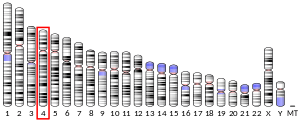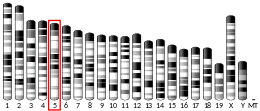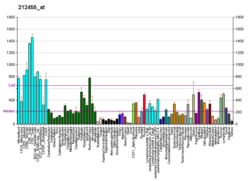YTHDC1
YTH domain-containing protein 1 is a protein that in humans is encoded by the YTHDC1 gene.[5][6][7] YTHDC1 is a nuclear protein involved in splice site selection that localises to YT bodies; dynamic subnuclear compartments, which first appear at the beginning of S-phase in the cell cycle and disperse during mitosis.[8]
Interactions
YTHDC1 has been shown to interact with:
Role in disease
Alternative splicing is altered in a number of diseases and is particuarly relevant to cancer.
Cancer
YTHDC1 has been shown to splice mRNA transcripts which have oncological importance, regulating tumour functions such as hypoxia associated vascular endothelial growth factor (VEGF), DNA damage associated breast cancer 1 (BRCA1) and hormonal growth driver; the progesterone receptor (PGR).[12][13]
In prostate cancer, YTHDC1 has also been shown to interact with the protein metadherin, encoded by the oncogene MTDH acting to influence alternative splicing of tumour-related genes such as CD44.[11][14]
See also
References
- ENSG00000083896 GRCh38: Ensembl release 89: ENSG00000275272, ENSG00000083896 - Ensembl, May 2017
- GRCm38: Ensembl release 89: ENSMUSG00000035851 - Ensembl, May 2017
- "Human PubMed Reference:". National Center for Biotechnology Information, U.S. National Library of Medicine.
- "Mouse PubMed Reference:". National Center for Biotechnology Information, U.S. National Library of Medicine.
- Stoilov P, Rafalska I, Stamm S (Oct 2002). "YTH: a new domain in nuclear proteins". Trends Biochem Sci. 27 (10): 495–7. doi:10.1016/S0968-0004(02)02189-8. PMID 12368078.
- Hartmann AM, Nayler O, Schwaiger FW, Obermeier A, Stamm S (Dec 1999). "The interaction and colocalization of Sam68 with the splicing-associated factor YT521-B in nuclear dots is regulated by the Src family kinase p59(fyn)". Mol Biol Cell. 10 (11): 3909–26. doi:10.1091/mbc.10.11.3909. PMC 25688. PMID 10564280.
- "Entrez Gene: YTHDC1 YTH domain containing 1".
- Nayler, O.; Hartmann, A. M.; Stamm, S. (2000-09-04). "The ER repeat protein YT521-B localizes to a novel subnuclear compartment". The Journal of Cell Biology. 150 (5): 949–962. doi:10.1083/jcb.150.5.949. ISSN 0021-9525. PMC 2175241. PMID 10973987.
- Rafalska I, Zhang Z, Benderska N, Wolff H, Hartmann AM, Brack-Werner R, Stamm S (Aug 2004). "The intranuclear localization and function of YT521-B is regulated by tyrosine phosphorylation". Hum. Mol. Genet. 13 (15): 1535–49. doi:10.1093/hmg/ddh167. PMID 15175272.
- Wilkinson FL, Holaska JM, Zhang Z, Sharma A, Manilal S, Holt I, Stamm S, Wilson KL, Morris GE (Jun 2003). "Emerin interacts in vitro with the splicing-associated factor, YT521-B". Eur. J. Biochem. 270 (11): 2459–66. doi:10.1046/j.1432-1033.2003.03617.x. PMID 12755701.
- Luxton, Hayley J.; Simpson, Benjamin S.; Mills, Ian G.; Brindle, Nicola R.; Ahmed, Zeba; Stavrinides, Vasilis; Heavey, Susan; Stamm, Stefan; Whitaker, Hayley C. (2019-08-23). "The Oncogene Metadherin Interacts with the Known Splicing Proteins YTHDC1, Sam68 and T-STAR and Plays a Novel Role in Alternative mRNA Splicing". Cancers. 11 (9). doi:10.3390/cancers11091233. ISSN 2072-6694. PMC 6770463. PMID 31450747.
- Hirschfeld, Marc; Zhang, Bo; Jaeger, Markus; Stamm, Stefan; Erbes, Thalia; Mayer, Sebastian; Tong, Xiaowen; Stickeler, Elmar (November 2014). "Hypoxia-dependent mRNA expression pattern of splicing factor YT521 and its impact on oncological important target gene expression". Molecular Carcinogenesis. 53 (11): 883–892. doi:10.1002/mc.22045. ISSN 1098-2744. PMID 23765422.
- Zhang, Bo; Shao, Xiaowen; Zhou, Jianhong; Qiu, Jin; Wu, Yi; Cheng, Jiajing (2015-08-21). "YT521 promotes metastases of endometrial cancer by differential splicing of vascular endothelial growth factor A". Tumour Biology: The Journal of the International Society for Oncodevelopmental Biology and Medicine. doi:10.1007/s13277-015-3908-y. ISSN 1423-0380. PMID 26289848.
- Yoo, Byoung Kwon; Emdad, Luni; Su, Zao-zhong; Villanueva, Augusto; Chiang, Derek Y.; Mukhopadhyay, Nitai D.; Mills, Alan Scott; Waxman, Samuel; Fisher, Robert A.; Llovet, Josep M.; Fisher, Paul B. (March 2009). "Astrocyte elevated gene-1 regulates hepatocellular carcinoma development and progression". The Journal of Clinical Investigation. 119 (3): 465–477. doi:10.1172/JCI36460. ISSN 1558-8238. PMC 2648696. PMID 19221438.
Further reading
- Imai Y, Matsuo N, Ogawa S, Tohyama M, Takagi T (1998). "Cloning of a gene, YT521, for a novel RNA splicing-related protein induced by hypoxia/reoxygenation". Brain Res. Mol. Brain Res. 53 (1–2): 33–40. doi:10.1016/S0169-328X(97)00262-3. PMID 9473574.
- Nayler O, Hartmann AM, Stamm S (2000). "The ER repeat protein YT521-B localizes to a novel subnuclear compartment". J. Cell Biol. 150 (5): 949–62. doi:10.1083/jcb.150.5.949. PMC 2175241. PMID 10973987.
- Stoss O, Olbrich M, Hartmann AM, Konig H, Memmott J, Andreadis A, Stamm S (2001). "The STAR/GSG family protein rSLM-2 regulates the selection of alternative splice sites". J. Biol. Chem. 276 (12): 8665–73. doi:10.1074/jbc.M006851200. PMID 11118435.
- Nagase T, Kikuno R, Ohara O (2002). "Prediction of the coding sequences of unidentified human genes. XXII. The complete sequences of 50 new cDNA clones which code for large proteins". DNA Res. 8 (6): 319–27. doi:10.1093/dnares/8.6.319. PMID 11853319.
- Wilkinson FL, Holaska JM, Zhang Z, Sharma A, Manilal S, Holt I, Stamm S, Wilson KL, Morris GE (2003). "Emerin interacts in vitro with the splicing-associated factor, YT521-B". Eur. J. Biochem. 270 (11): 2459–66. doi:10.1046/j.1432-1033.2003.03617.x. PMID 12755701.
- Rafalska I, Zhang Z, Benderska N, Wolff H, Hartmann AM, Brack-Werner R, Stamm S (2005). "The intranuclear localization and function of YT521-B is regulated by tyrosine phosphorylation". Hum. Mol. Genet. 13 (15): 1535–49. doi:10.1093/hmg/ddh167. PMID 15175272.
- Beausoleil SA, Jedrychowski M, Schwartz D, Elias JE, Villén J, Li J, Cohn MA, Cantley LC, Gygi SP (2004). "Large-scale characterization of HeLa cell nuclear phosphoproteins". Proc. Natl. Acad. Sci. U.S.A. 101 (33): 12130–5. doi:10.1073/pnas.0404720101. PMC 514446. PMID 15302935.
- Stoss O, Novoyatleva T, Gencheva M, Olbrich M, Benderska N, Stamm S (2005). "p59(fyn)-mediated phosphorylation regulates the activity of the tissue-specific splicing factor rSLM-1". Mol. Cell. Neurosci. 27 (1): 8–21. doi:10.1016/j.mcn.2004.04.011. PMID 15345239.
- Kimura K, Wakamatsu A, Suzuki Y, Ota T, Nishikawa T, Yamashita R, Yamamoto J, Sekine M, Tsuritani K, Wakaguri H, Ishii S, Sugiyama T, Saito K, Isono Y, Irie R, Kushida N, Yoneyama T, Otsuka R, Kanda K, Yokoi T, Kondo H, Wagatsuma M, Murakawa K, Ishida S, Ishibashi T, Takahashi-Fujii A, Tanase T, Nagai K, Kikuchi H, Nakai K, Isogai T, Sugano S (2006). "Diversification of transcriptional modulation: large-scale identification and characterization of putative alternative promoters of human genes". Genome Res. 16 (1): 55–65. doi:10.1101/gr.4039406. PMC 1356129. PMID 16344560.
- Nousiainen M, Silljé HH, Sauer G, Nigg EA, Körner R (2006). "Phosphoproteome analysis of the human mitotic spindle". Proc. Natl. Acad. Sci. U.S.A. 103 (14): 5391–6. doi:10.1073/pnas.0507066103. PMC 1459365. PMID 16565220.
- Beausoleil SA, Villén J, Gerber SA, Rush J, Gygi SP (2006). "A probability-based approach for high-throughput protein phosphorylation analysis and site localization". Nat. Biotechnol. 24 (10): 1285–92. doi:10.1038/nbt1240. PMID 16964243.
- Olsen JV, Blagoev B, Gnad F, Macek B, Kumar C, Mortensen P, Mann M (2006). "Global, in vivo, and site-specific phosphorylation dynamics in signaling networks". Cell. 127 (3): 635–48. doi:10.1016/j.cell.2006.09.026. PMID 17081983.




